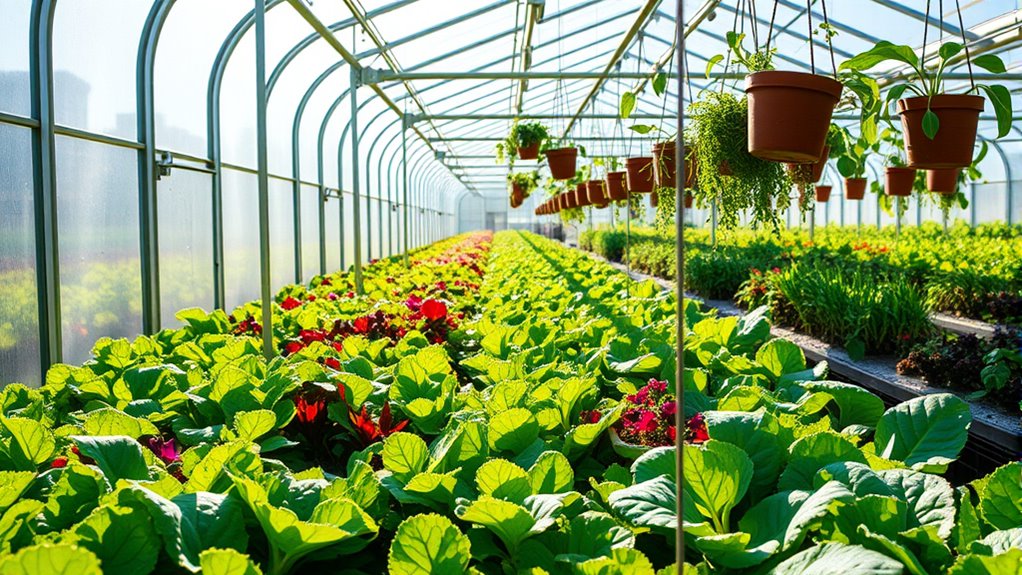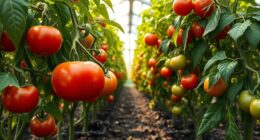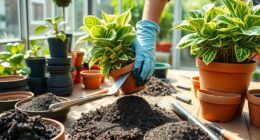Greenhouse gardening supports sustainable living by allowing you to grow food year-round, which reduces reliance on imported produce and cuts down on food miles. It helps conserve water and energy through eco-friendly practices like rainwater harvesting and solar power. Plus, you can promote biodiversity by using organic methods and attracting beneficial insects. By adopting these techniques, you contribute to a healthier environment while ensuring fresh, local food—more ways to explore await.
Key Takeaways
- Greenhouse gardening enables year-round cultivation, reducing reliance on imported produce and lowering food miles and transportation emissions.
- It promotes resource conservation through water-efficient systems, renewable energy use, and sustainable materials, supporting environmental preservation.
- Growing local food in greenhouses enhances community food security and reduces food waste by harvesting crops at peak ripeness.
- Incorporating biodiversity and eco-friendly pest management creates resilient ecosystems that naturally sustain plant health and minimize chemical use.
- Sustainable practices like seed saving and composting preserve heirloom varieties and recycle organic waste, reducing environmental impact.
Extending Growing Seasons and Reducing Food Waste
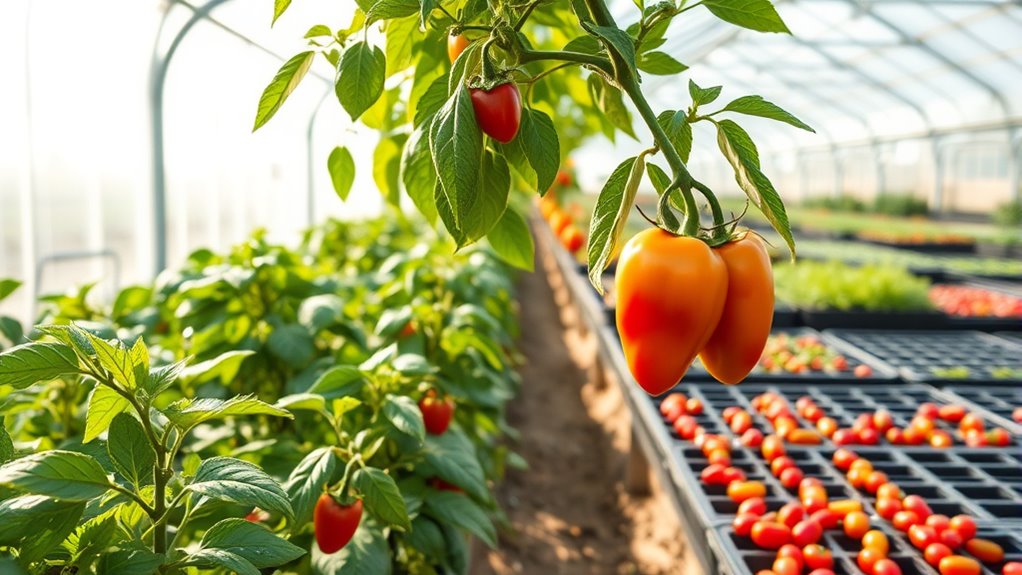
Greenhouse gardening allows you to extend your growing seasons beyond outdoor limits, giving you the flexibility to cultivate crops even when outdoor conditions aren’t ideal. By controlling temperature and humidity, you can grow fresh produce year-round, reducing the need to buy food out of season.
This approach also helps minimize food waste because you harvest ripe crops at peak freshness. Incorporating composting practices into your greenhouse routine recycles organic waste, enriching your soil naturally and supporting sustainable growth. Additionally, using vintage decor in your greenhouse can create an inviting environment that encourages longer enjoyment of your plants and produce. Proper community support features can further enhance your gardening success by connecting you with other enthusiasts and sharing sustainable techniques.
Furthermore, seed saving becomes easier, allowing you to preserve heirloom varieties and reduce dependency on commercial seed sources. These practices ensure your greenhouse remains productive and environmentally friendly, helping you enjoy fresh, homegrown food while actively reducing waste and supporting sustainable living. Implementing sustainable techniques can further enhance the eco-friendly benefits of your greenhouse efforts. For example, utilizing eco-friendly materials like recycled or biodegradable supplies can minimize environmental impact. Additionally, understanding market research can help you select the most suitable crops for your climate and community needs.
Minimizing Food Miles and Supporting Local Food Systems
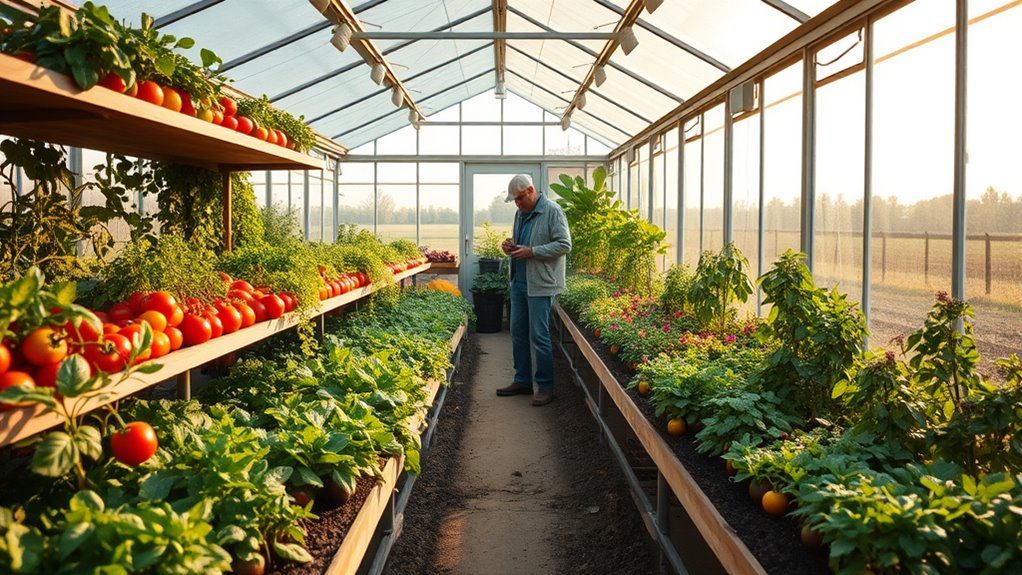
By growing your own food or buying locally, you can cut down on transportation emissions and help the environment. Supporting nearby farms also boosts your community’s food security and resilience. Incorporating local food systems into your lifestyle fosters a more sustainable future for everyone. Additionally, adopting eco-friendly practices like water-efficient fixtures can further reduce your environmental impact.
Reducing Transportation Emissions
Reducing transportation emissions is a key way to lower the environmental impact of your food choices. By growing food locally in your greenhouse, you cut down on food miles, decreasing greenhouse gases from transportation. Supporting local food systems also encourages sustainable practices, like using solar power to energize your greenhouse, which further reduces emissions. Healthy soil is essential for productive, resilient crops, minimizing the need for external inputs. Here’s a comparison of key factors:
| Factor | Impact |
|---|---|
| Food miles | Reduces emissions by localizing production |
| Solar power | Lowers energy-related emissions |
| Soil health | Promotes sustainable growth, less need for imports |
| Transportation | Eliminated by local cultivation |
| Food system support | Strengthens community resilience |
Focusing on these aspects helps you decrease transportation emissions and supports sustainable living.
Enhancing Community Food Security
Enhancing community food security relies heavily on minimizing food miles and supporting local food systems. Urban agriculture, including greenhouse gardening, allows you to grow fresh produce close to home, reducing reliance on distant sources. By cultivating food locally, you cut down transportation emissions and ensure year-round access to nutritious crops. Implementing eco-friendly practices in greenhouse gardening, such as water-efficient systems and sustainable materials, further contributes to toilet cleaner effectiveness and overall environmental impact. Supporting local food systems fosters community resilience and encourages sustainable practices. Additionally, seed saving plays a crucial role, allowing you to preserve heirloom varieties adapted to your climate, ensuring seed availability for future seasons. Engaging in sustainable gardening techniques can enhance soil health and reduce the need for chemical inputs. These practices empower you to contribute to a more self-sufficient community, decrease dependency on large-scale supply chains, and promote equitable access to healthy food. Incorporating sustainable gardening practices can also help mitigate the effects of climate change on local agriculture. For instance, selecting climate-resilient crops that are better adapted to changing weather patterns can improve crop yields despite environmental challenges. Moreover, growing chia seeds indoors or in greenhouses is an excellent example of how resilient and easy super seeds are to cultivate in controlled environments, ensuring consistent food production. Ultimately, integrating greenhouse gardening into urban agriculture strengthens community food security and supports sustainable living.
Promoting Organic and Chemical-Free Cultivation
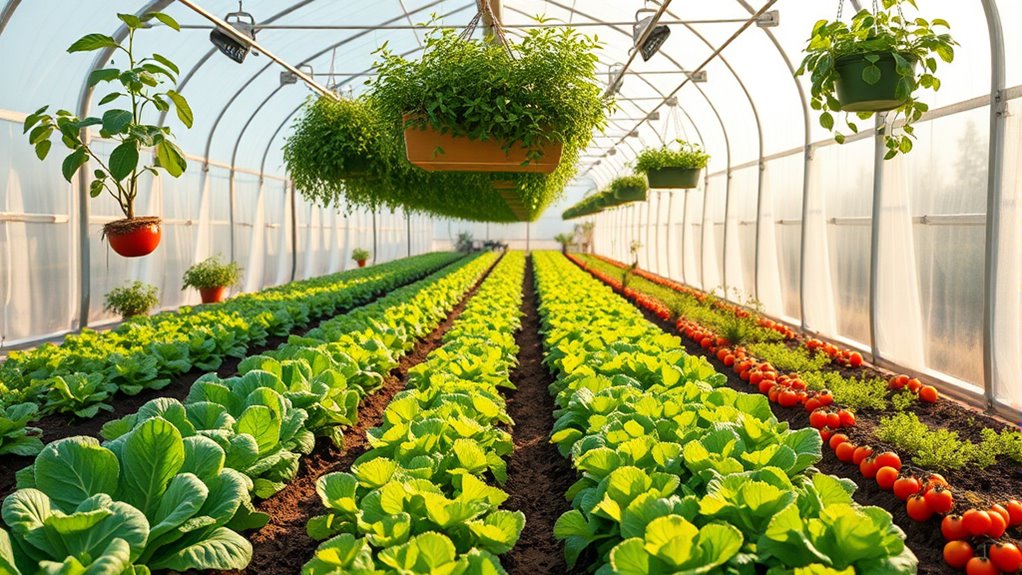
Promoting organic and chemical-free cultivation is essential for creating sustainable and healthy greenhouse environments. By focusing on soil health, you improve the nutrient balance naturally, reducing the need for synthetic fertilizers and pesticides.
Implementing crop rotation helps prevent soil depletion and disrupts pest and disease cycles, making your greenhouse more resilient. This approach encourages beneficial microorganisms, which support plant growth and improve soil structure. Additionally, using integrated pest management strategies can further reduce reliance on chemical controls, fostering a more balanced ecosystem.
Crop rotation prevents soil depletion and enhances resilience by supporting beneficial microorganisms and disrupting pests.
When you avoid chemicals, you protect pollinators and reduce water contamination, fostering a healthier ecosystem around your greenhouse. Organic practices also lead to tastier, more nutritious produce, aligning with sustainable living goals.
Additionally, understanding fertilizer application techniques can influence market dynamics for organic produce, supporting local economies and encouraging sustainable farming methods. Employing natural amendments such as compost and organic matter further enhances soil fertility without synthetic inputs. Using soil testing can help you determine the precise nutrient needs of your plants to avoid over-application. Ultimately, prioritizing organic and chemical-free methods guarantees your greenhouse remains environmentally friendly and productive over the long term.
Conserving Water and Energy Resources
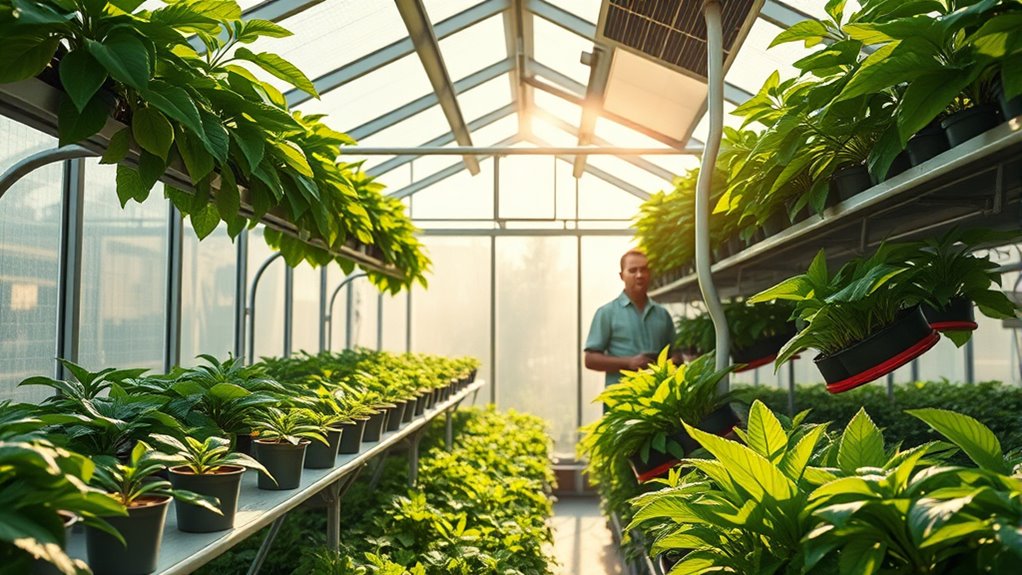
Have you considered how conserving water and energy can make your greenhouse more sustainable? Reducing water use through drip irrigation or rainwater harvesting helps with resource preservation and enhances climate adaptation. Arcade machines, like the classic Galaga, demonstrate how specialized hardware and regular maintenance are essential for longevity and performance, similar to sustainable greenhouse practices. Incorporating energy-efficient technology such as LED lighting and smart thermostats can further optimize resource use and reduce waste. Installing energy-efficient lighting, heaters, and ventilation minimizes electricity consumption and lowers your carbon footprint. Proper insulation keeps temperatures stable, reducing the need for artificial heating or cooling. Using renewable energy sources like solar panels further supports resource preservation and sustainable practices. Additionally, implementing efficient energy use strategies can significantly decrease overall energy requirements and emissions. These measures not only save costs but also lessen environmental impact, making your greenhouse more resilient to climate changes.
Encouraging Biodiversity and Eco-Friendly Pest Management
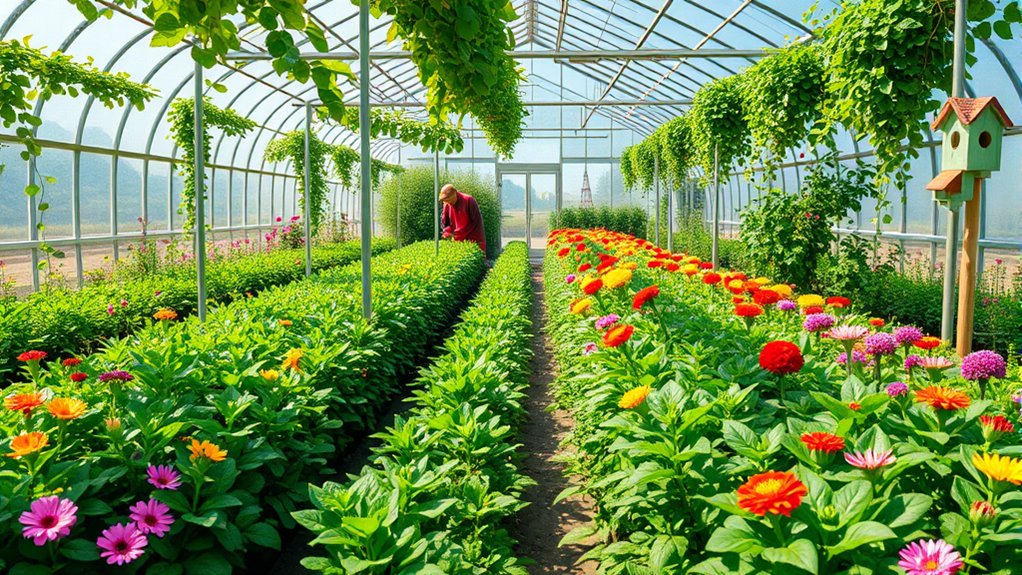
To support a healthy greenhouse, focus on natural pest control methods like introducing beneficial insects and using organic repellents.
Encouraging plant diversity attracts a variety of wildlife that helps keep pests in check naturally. By mixing different plant species, you create a balanced environment that promotes overall biodiversity and reduces the need for chemical interventions.
Natural Pest Control Methods
Encouraging biodiversity in your greenhouse creates a natural barrier against pests by fostering a balanced ecosystem. One effective method is companion planting, where you grow certain plants together to repel pests or attract beneficial insects.
For example, marigolds deter nematodes, while basil repels aphids. Biological control also plays a crucial role; introducing natural predators like ladybugs or predatory mites helps keep pest populations in check without chemicals.
These eco-friendly strategies reduce reliance on chemical pesticides, supporting sustainable gardening. By promoting diverse plant relationships and encouraging beneficial insects, you create an environment where pests are naturally managed.
This not only protects your crops but also maintains the ecological health of your greenhouse, aligning with sustainable living principles.
Promoting Plant Diversity
Promoting plant diversity in your greenhouse naturally enhances pest management by creating a resilient and balanced ecosystem. By including a variety of native plants and establishing pollinator habitats, you support beneficial insects that control pests naturally. Preserving native plants helps maintain local biodiversity and strengthens ecological stability. Incorporate plants with different flowering times to ensure continuous resources for pollinators. Consider the following table to diversify your greenhouse:
| Native Plants | Pollinator Habitats | Pest-Resistant Species |
|---|---|---|
| Milkweed | Bee Hotels | Marigolds |
| Coneflower | Wildflower Mix | Basil |
| Goldenrod | Butterfly Gardens | Nasturtiums |
This approach encourages eco-friendly pest management and promotes a sustainable, vibrant environment inside your greenhouse.
Reducing Dependence on Imported Produce
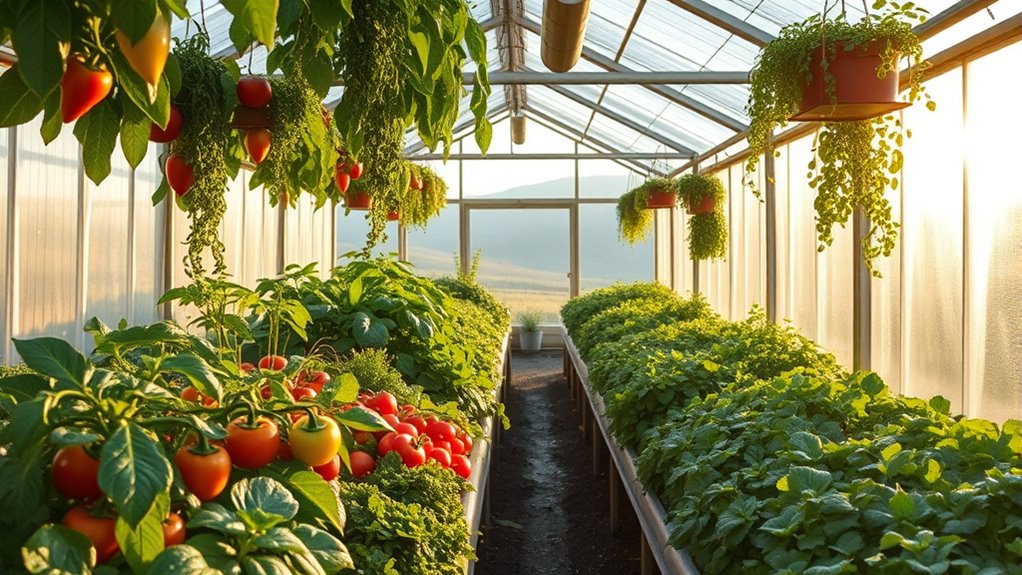
Growing your own produce in a greenhouse reduces your reliance on imported goods and guarantees fresher, more sustainable food for your table. If you have an urban rooftop greenhouse, you can grow vegetables and herbs right where you live, cutting down on transportation emissions and packaging waste.
An indoor microclimate allows you to control temperature, humidity, and light, creating ideal conditions for year-round harvests. This independence from store-bought produce not only lowers your carbon footprint but also assures you have access to organic, pesticide-free food whenever you need it.
Utilizing Sustainable Materials and Technologies in Greenhouse Design
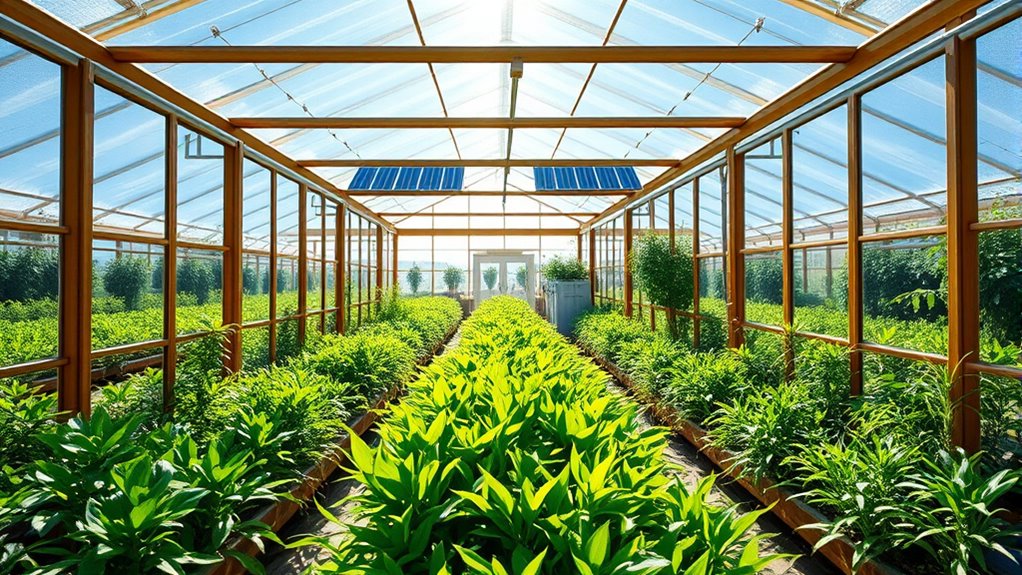
To create an eco-friendly greenhouse, you should prioritize sustainable materials and innovative technologies that minimize environmental impact.
Using reclaimed materials like salvaged wood or recycled metal reduces waste and lowers the need for new resource extraction.
Incorporating renewable energy sources, such as solar panels or wind turbines, helps power your greenhouse sustainably, reducing reliance on fossil fuels.
These technologies can offset energy costs and ensure a clean, efficient environment for your plants.
Additionally, opt for eco-conscious insulation and glazing options that maximize heat retention and natural light, decreasing energy consumption.
Enhancing Community Engagement and Education in Sustainability
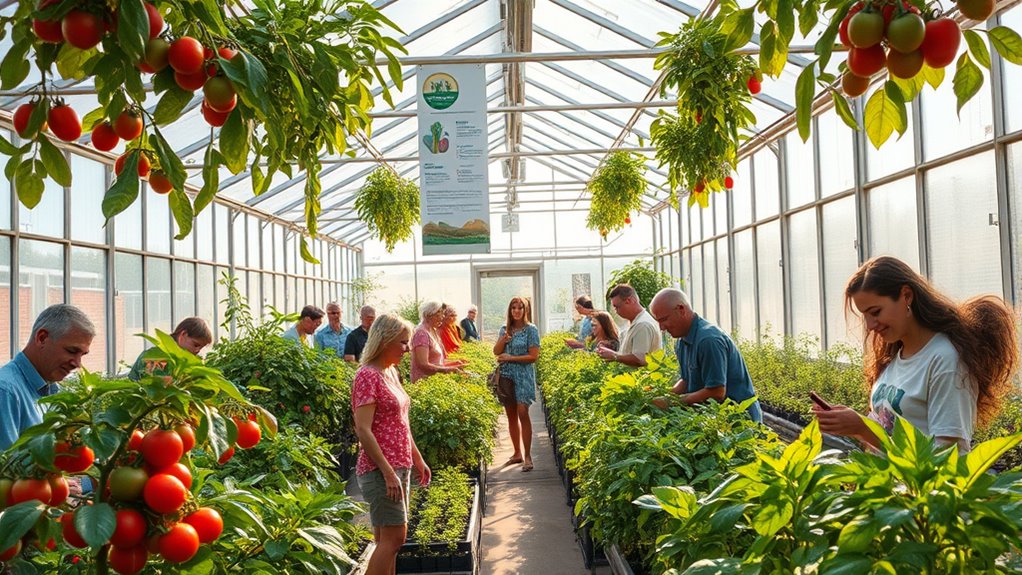
Greenhouses serve as essential hubs for community engagement and education in sustainability. They offer a hands-on environment where you can host community workshops focused on sustainable gardening, composting, and eco-friendly practices.
Greenhouses also provide the perfect setting for youth programs, inspiring the next generation to appreciate and care for the environment. By involving local residents in planting, maintenance, and educational activities, you foster a sense of ownership and responsibility.
This active participation helps spread awareness about sustainable living and encourages community-wide efforts. Greenhouses become more than just growing spaces—they transform into vibrant centers for learning, collaboration, and environmental stewardship, making sustainability accessible and engaging for everyone involved.
Frequently Asked Questions
How Do Greenhouses Contribute to Reducing Greenhouse Gas Emissions?
Greenhouses help reduce your carbon footprint by allowing you to grow plants year-round locally, minimizing the need for long-distance transportation.
They also enhance energy efficiency through insulation and controlled environments, reducing the energy required for heating and cooling.
What Are the Initial Costs and Long-Term Savings of Greenhouse Gardening?
A thorough cost analysis shows that greenhouse gardening has high initial costs, often around $2,000 to $10,000 depending on size and features.
However, you’ll enjoy long-term savings through reduced grocery bills and fewer trips for fresh produce.
This investment benefits your wallet and the environment by lowering your carbon footprint.
While the upfront costs are significant, the ongoing savings and sustainable benefits make it a smart, cost-effective choice over time.
How Can Greenhouses Be Integrated Into Urban Environments Effectively?
You can effectively integrate greenhouses into urban environments by utilizing vertical integration, stacking plants to maximize space and improve air quality.
Engage your community through educational programs, workshops, and shared gardening spaces that foster collaboration and awareness. This approach not only optimizes land use but also builds a sense of shared responsibility, making greenhouses a sustainable and essential part of city life.
It also promotes local food production and environmental benefits.
What Are Common Challenges Faced in Maintaining Sustainable Greenhouse Systems?
In maintaining sustainable greenhouse systems, you often face challenges like managing pests without harming the environment, emphasizing sustainable pest management.
Efficient water use is also vital, requiring you to optimize irrigation and recycling systems to avoid waste.
Balancing pest control and water conservation can be tricky, but by adopting eco-friendly practices and innovative technologies, you guarantee your greenhouse remains productive and sustainable while minimizing environmental impact.
How Does Greenhouse Gardening Impact Local Biodiversity Beyond Plant Life?
Greenhouse gardening impacts local biodiversity by supporting pollinators like bees and butterflies, which are essential for healthy ecosystems. Your efforts create habitat diversity, providing shelter and food sources beyond just plants.
This encourages a balanced environment, attracting beneficial insects and small wildlife. By fostering pollinator support and habitat diversity, your greenhouse helps sustain local species and promotes ecological resilience.
These benefits ultimately support the broader community and environment.
Conclusion
By embracing greenhouse gardening, you actively support sustainability—extending growing seasons, reducing waste, and cutting down on food miles. As you cultivate organic produce with eco-friendly methods, you help conserve resources and promote biodiversity. Using sustainable materials and engaging your community, you become part of a cycle that benefits both the environment and local food systems. Greenhouse gardening isn’t just a practice; it’s a powerful way to nurture a healthier planet for future generations.
